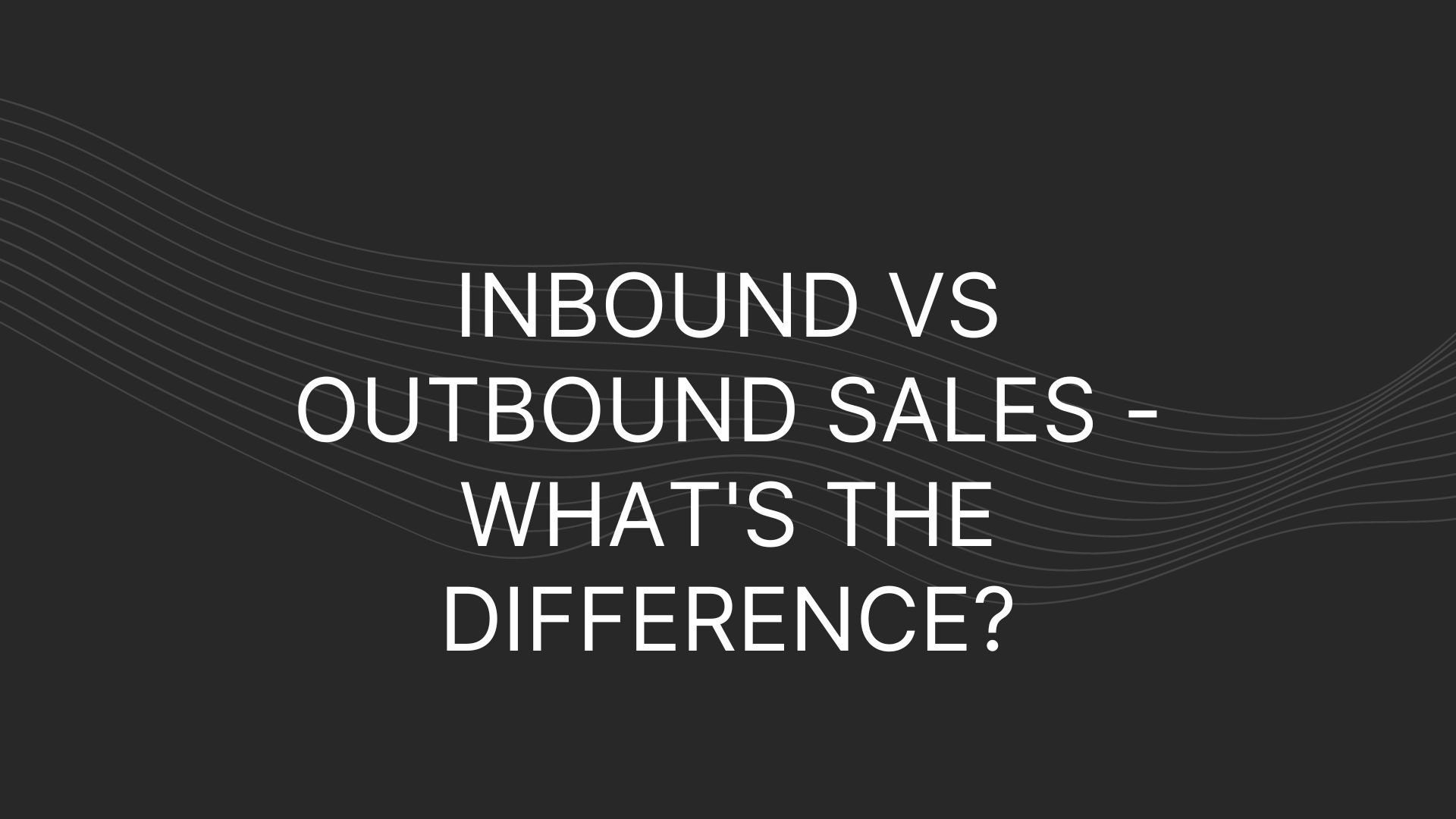Are you looking to better understand the differences between Inbound vs outbound sales? In this article, we’ll cover everything you need to know whether you’re a new business owner or a VP of sales who needs to share some educational content with a technical founder.
Often, companies have to decide on which model to focus their resources when it comes to inbound versus outbound sales. Outbound and inbound sales should never be an either or. Rather, you should have a goal to incorporate both sales strategies.
What is Inbound Sales?
Inbound sales is when a prospect comes to your company on their own. These prospect tend to convert at a much higher rate because they are ready to speak with sales.
Inbound sales however does not happen overnight. For inbound sales to work, you’ll need a few things going right. First, you’ll need prospects who are aware of your company and offering. If nobody knows who you are, then you will not have any inbound sales. To get that point where you have inbound sales, you’ll need to focus on marketing.
A few marketing tactics that can drive inbound sales include
- SEO
- Adwords/Paid Search
- LinkedIn Social Selling
- Brand building
- Podcast Appearances
- Newsletters
- Word of Mouth/Referrals
- Account Based Marketing
- Paid leads
By focusing on one or all of the above, a marketing team can drive awareness and interest which results in inbound leads. These inbound leads are then handled by a salesperson who will attempt to close the business.
Because clients are coming to a client to start the sales conversation, these are considered inbound sales.
What is Outbound Sales?
Outbound sales is when a sales team proactively goes after a prospect who is not coming to them to have a sales conversation. The prospect may be interested in their offering but the conversation is started by the salesperson and the prospect has not actively demonstrated a desire to talk to salespeople.
Outbound sales is often lead by SDRs or BDRs depending on the company. Their outbound sales tactics include:
- Cold calling
- Cold emailing
- Sending LinkedIn messages
- Video prospecting
- Leveraging Twitter messages
For the most part, outbound sales people lead the charge to generate business. This is often supported by Marketing because marketing can help “warm up” prospects.
A key characteristic with outbound sales is that the salesperson is responsible for getting the prospect to agree to a first meeting. Depending on the sales organization this may be lead by the SDR/BDR or Account Executive.
What is The Difference Between Inbound vs Outbound Sales?
When comparing inbound vs outbound sales, the main difference is who initiates the sales conversation.
With inbound sales, the prospect has come to the company to begin a sales conversation. Whereas with outbound sales, the salesperson initiates the sales conversation.
Other differences between inbound vs outbound sales include the conversion rate. Inbound leads are much more likely to convert because your prospect has very likely done research before reaching out. They’re in the evaluation process. They would not reach out to talk to a salesperson for the fun of it. They are seriously considering your solution or at the very least, in the research phase. However, when comparing outbound sales vs inbound sales, outbound sales leads convert at a lower rate because a prospect may not be ready to start evaluating solutions or hasn’t even thought of the problem you’re able to solve. They tend to be earlier in the buying process or more likely not in a buying process.
When it comes to who leads the charge for inbound vs outbound sales, the division of labor is clear. For inbound leads, the marketing department is going to play a major role. But when compared to outbound sales, most of the responsibility is left to the sales team. A team made up of SDRs, Sales Development Managers, and AEs.
A third difference between outbound and inbound sales is the cost per lead. Given the higher conversion rate of inbound leads, it’s natural the cost per lead is going to be higher. This is because marketing will spend resources increasing brand awareness, educating the market, and driving traffic to the website. Whereas outbound sales can quite affordable since only a few B2B sales tools would be required.
A final difference between outbound vs inbound sales is the time to generate a lead. With outbound sales, an SDR could literally pick up the phone and book a meeting. That can take a minute. Inbound sales on the other hand can take months to generate an inbound lead. That’s why early stage startups should focus on outbound sales when they get started. But companies with resources should also invest in inbound sales.
| Inbound Sales | Outbound Sales | |
| Who Initiates Sales Convo? | Prospect | Company |
| Conversion Rate | Above Average | Average to Below |
| Who leads? | Marketing | Sales |
| Cost per lead | Higher | Lower |
| Time to generate lead | Higher | Lower |
Which is better, Inbound vs Outbound Sales?
Typically, neither is better. In a perfect world if you could generate all inbound leads to support your organization, that would be a dream scenario. However, that is unrealistic so there isn’t a right answer for which is better when it comes to inbound vs outbound sales. Companies need to focus on both. Each has their own advantage.
Getting inbound sales to work which relies on marketing to generate leads requires a substantial investment. However, this is investment when your company has product market fit and the deal size justify the investment, it is a no brainer. Inbound sales can work for every company but not all companies can execute on inbound sales.
Another consideration of inbound sales vs outbound is who is your prospect? Some prospects do not respond to cold outreach or are incredibly hard to get ahold of. In that case, prioritizing an inbound sales strategy is important. If you’re able to acquire meetings with prospects via outbound sales, then the decision of which is better, inbound vs outbound sales is a bit easier.
Outbound sales is going to be a better fit for early stage startups because they can leverage different prospecting strategies to book meetings with prospects. Sending cold emails may land you a client in a week. Whereas building out an SEO strategy to drive inbound leads could take months.
Outbound vs Inbound Sales Challenges
When it comes to outbound vs inbound sales challenges, it’s important to understand the stage of your company and the resources available. Not all challenges are created equally. If your company is an established brand with a large budget and you haven’t tried inbound or outbound sales, it is well worth the experiment.
The real challenge lies in executing.
Outbound sales are challenging because it sounds easy. You build a cold call list, you buy business leads, get a sales engagement platform and you’re off. However, outbound sales challenges are real.
Here are some outbound sales challenges:
- Noisy – Given the cost, perceived ease of execution, and proliferation of sales tools for prospecting, prospects are inundated with cold outreach.
- Lots of Rejection – Most people who have never done outbound sales are not comfortable with the level of rejection they’ll face.
- Low Conversion Rate – Most of the work done will result in nothing and when meetings are booked, they will not convert at a high rate
- Skills Needed – A lot of people think they have the sales skills to do outbound but the data says otherwise
- Hated – Many prospects hate receiving cold calls and cold emails and will not react positively to them
- Requires consistent effort – You can set automated emails but they wont perform well and you still can’t automate cold calling
- Headcount – You’ll need a certain number of outbound salespeople because outbound salespeople are bottlenecks for scaling outbound
Here are some inbound sales challenges:
- Time to lead – It can take months to generate the first qualified leads
- Expensive – Inbound sales is expensive because marketing is expensive, especially in the B2B space. This can include an SEO budget
- Skills Needed – Writing content, nurturing prospects, building landing pages, etc, requires legitimate skills and isn’t easy to find
- Out of Your Control – When comparing inbound vs outbound sales, inbound sales relies on the effort of prospects to make the critical move. Outbound sales relies on their own effort and is in much more control of the outcome.
- Lack of flexibility – Getting inbound sales right takes time and unlike outbound sales, you cannot quickly change course given the time required to test proper channels.
There are various inbound vs outbound sales challenges to consider. Depending on your resources, the challenges may not prevent you from executing on one or both. Your prospect may also influence your outbound vs inbound sales approach.
Inbound Vs Outbound Sales Benefits
Both inbound and outbound sales have numerous benefits. Given how different inbound vs outbound sales is, the benefit for one approach tends to be the opposite for the other.
The top benefit of outbound sales compared to inbound sales is the ability to hyper target your prospect. If you want to go after the VP of Finance because you have a SaaS spend management solution you want to sell, you can craft a cold email in Salesloft and send it off.
More outbound sales benefits
Other benefits include volume of outreach that can scale without increasing your cost a ton. Assuming you have the headcount, you can scale cold outreach as long as you have the prospect’s contact info. You can go from contacting hundreds of prospects a day to thousands. Outbound also puts you in control. You are not at the mercy of Google’s search algorithm and you can quickly make changes to your strategy. If there is news or a trigger event, your outbound sales approach can be made more relevant.
Another benefit of outbound vs inbound sales is the cost. A solo founder can acquire customers for $99 a month using a tool like Apollo. This isn’t possible with inbound sales.
Flexibiliy is an often overlooked benefit of outbound sales. If you realize your approach isn’t working because large organizations do not want your solution, you can easily pivot. When comparing inbound vs outbound sales, outbound sales wins in this regard.
After reading the above, you may think that outbound sales vs inbound is a no brainer. For early stage companies it often is but not always. For later stage companies, they tend focus more on inbound sales versus outbound sales as they grow because they’re simply scaling outbound that has worked before.
The top inbound sales benefit is the higher converting lead. Lead quality for people who are ready to buy is significantly higher for inbound versus outbound sales. This prospect has decided to take time out of their busy day to talk to a salesperson. Compare to outbound sales where you’ve likely interrupted them.
Here are inbound sales benefits
The work you’ve done to generate inbound sales versus outbound sales can sometimes be put on autopilot. Once you’ve cracked the SEO rankings and are able to convert a high enough percentage of web traffic, you’ll be able to reap benefits from this work every day for as long as you rank.
It will take time to figure out what ads work to generate leads but if you can solve this challenge, you may be able to “set it and forget it” for a bit. Outbound vs inbound sales benefits are clear in this case. Outbound requires continuous work. Inbound, less so to generate leads once the engine is running.
Another benefit outbound inbound sales is morale. Salespeople love getting inbound sales leads because these prospects are often (somewhat) excited to talk to a salesperson. They’re further along in their buying process.
Inbound sales is also able to target people who do not want to or do not respond to outbound sales. Certain industries only work with a high functioning inbound sales department.
Inbound vs Outbound Sales Tools
When it comes to inbound vs outbound sales tools, simply put, there are a lot to choose from.
Inbound Sales Tools usually include more marketing focused tools that support the Inbound Sales Process.
- ABM platforms
- Tools to help track visitor’s journey’s on a site
- Lead routing software like Chili Piper and Calendly
- SEO tools like Ahrefs and SEMRush
Outbound Sales Tools are plentiful. There are a ton of B2B sales tools to choose from that support an outbound sales approach.
- B2B database providers like ZoomInfo, Cognism, and many others.
- Sales Engagement platforms for outbound sequences like Salesloft, Outreach, Apollo
- Tools to make more cold calls like Orum, Connect and Sell, Kixie
- Intent data providers
- LinkedIn Automation Tools
Outbound vs Inbound Sales Process
The process for inbound vs outbound sales has a couple differences.
Inbound sales
- Marketing generates Interest
- Prospect comes to company to book a time to chat or self serves on website
- Meeting is conducted and sales process continues as any other sales process
Outbound sales
- Prospect lists are created
- Outbound salespeople conduct cold outreach
- A prospect books a meeting time to speak with the company
- Meeting is conducted and sales process continues as any other sales process



